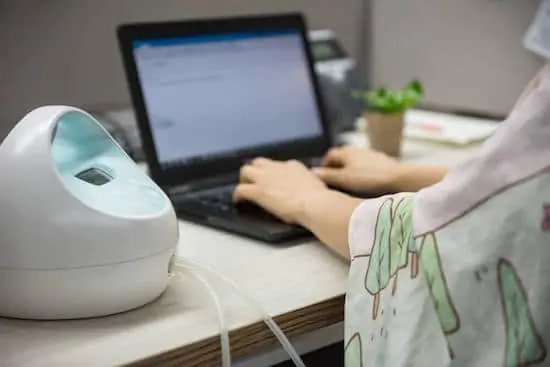It’s not easy to kiss those chubby baby cheeks goodbye for 8 hours and go to work. While it’s nice to see coworkers you like and have a grown-up conversation with other people, being apart from your baby is tough. And if you’re breastfeeding, you have the added challenges of breast pumping while on the clock.
I was lucky that in China, they were wonderfully accommodating for me. The director of our teaching team made sure that the times that were best for my pumping were left free for me. She had a clean, private, and quiet space for me to pump, plus there was a mini-fridge in our teaching lounge where I could store my breastmilk until I got home. It was a sweet gig.
Oddly enough in America, things can be trickier to navigate.
There is still much progress that needs to be made for working moms. In a perfect world, perhaps every mom would stay home and get those baby snuggles. Then again though, having your own career is a pretty amazing thing too. Why should we have to choose?
Thankfully, the ACLU has your back with some things you should read up on before returning to your workplace. Just because there are laws in place to help and protect you doesn’t mean that every boss is aware of it. And look at what I posted about bringing breastmilk on an airplane! Remember that?
You can’t count on anyone else to know all the rules so count on yourself.
What are the Laws for Pumping at the Workplace?
- While there are more specific laws for each state, on the federal level, this is what you should know, in a nutshell:
- Hourly workers have the right to pump as per the Fair Labor Standards Act.
- You must be permitted reasonable break time to express milk for one year after your child’s birth.
- You must be provided a place (not the bathroom) where you can privately express breastmilk.
- Employers that are covered don’t have to give you paid breaks for pumping.
- Your employer can’t refuse to pay you even if you used your paid breaks to pump milk.
Because we all have different jobs, you can fill out an interactive form that will help you figure out things in your particular situation.
How Often Can You Pump at Work?
I’ve talked about successful pumping in another post. But for pumping frequency, you have to realize that in the beginning, you will be spending more time pumping than you will in the future as your baby grows.
According to the United States Breastfeeding Committee (USBC), you should be pumping about as frequently as your baby eats, roughly every 2 to 3 hours during your work time. That’s only in the beginning, though. As I said, the more time goes on, the less that will be.

Additionally,
Your breasts will get used to pumping and you’ll be getting your milk out that much faster. So your breaks won’t take as long after time goes by, but you are protected by law and no one should discriminate against you.
The USBC also estimates that each breast-pumping working mama should be prepared to take about 15 to 20 minutes per pumping session plus the time it takes to set up, clean, and pack up the pumping supplies. This is what has been referred to as “reasonable” time allowed for pumping milk at work.
State Guides on Breast Pumping at Work
The United States Department of Labor has an informative, albeit incredibly boring, set of FAQs about what breast pumping moms are and aren’t entitled too. I’ve given you a basic rundown of it above, however, I think it’s very wise if you’re just about to return to work after having your baby that you keep a copy of this with you in case you need it.
Note that:
For those of you working in bigger offices, it’s very likely that your HR team is ready with everything you need. But for smaller offices or those doing shift work, you may have some challenges. Ideally, everything will go smoothly for you when you return.

Now, to complicate things even further, there are guidelines that are state-specific. I know, isn’t this fun? Definitely go check out the link for your state. I’m also linking this USDA Nursing Mother’s Support Handbook which has loads of helpful info for moms heading back to work after baby.
Some states are more forward-thinking than others when it comes to breastfeeding and breast pumping in the workplace. The three best states for new moms are California, New York, and Illinois. These states go above and beyond the call of their duties as required by law to make nursing moms’ lives a whole heck of a lot easier.
Of those three though, California, my new home state, leads the pack. It requires all employers to give breastfeeding employees – salaried and hourly –private space and break time. They also signed a major act into place to require every major airport to provide private lactation areas beyond the security points.
Other states that rank highly on breastfeeding/pumping friendliness are Colorado, Indiana, Maine, Massachusetts, Minnesota, New Jersey, New Mexico, Oregon, Rhode Island, Tennessee, and Vermont.
How Do You Manage to Pump at Work?
The first thing you should do is review the requirements in your state. Ideally, before you take maternity leave, you should be discussing this with your boss and the HR department. If you work for a small company, be prepared with your paperwork as they might not be fully aware of what they are required to provide.
Most companies do not want to get in trouble for not providing the proper benefits to employees. Small companies cannot make you pump in the bathroom though. It’s so important you know your rights in your state, so please read up.
As for stress levels, I recently posted about pumping and getting used to it (go check it out!). I urge you to practice pumping at home when you’re relaxed and have time to get used to your pump rather than trying to pump for the first time ever at your office.
Even if your employer has created the world’s most amazing lactation room, you likely won’t get a drop of milk out of it if you’ve never tried pumping.
Bottom Line
Your rights are protected, but if you don’t know anything about them, you can easily be underpaid or made to pump in a place that doesn’t make you feel comfortable (like the gross bathroom for example). Remember those old G.I. Joe cartoons growing up? “Knowing is half the battle.” Hey, my brother liked to watch it. Anyway, that point is still valid today.
And that point is being informed only helps you. So if your state allows you to have a paid break for your lactation needs, you don’t want to miss out on that, do you? It keeps you from being taken advantage of or missing out on something that your employer should provide to you because they are uneducated/unaware of the laws.
Some of my happiest memories are of breastfeeding my daughters. I’m very fortunate I worked in a place that put my health and comfort as a priority for them. Hopefully, you won’t have any trouble in your workplace.
I think I’ve also mentioned when I traveled through Seoul how amazing that airport was for lactating moms. There were lactation rooms and nurseries just outside our gate. It made it so easy for privacy, and it was immaculately clean. Additionally, it had a bigger play area for toddlers which was great for moms with a new baby and an active toddler.
I saw one mom sitting there nursing her little baby while her older son was able to roam about in a safe, enclosed area. To me, that was sheer brilliance. 🙂
Anyway, start that dialogue with your boss today so you can pump worry-free at work tomorrow!
Leslie Berry lives with her husband and two young daughters in Los Altos, California, where she loves helping other moms get comfortable with motherhood and embracing the insanity with facts peppered with laughs.
She loves eating too much sushi, exercising, and jamming out on her Fender. Read more about Leslie here.






